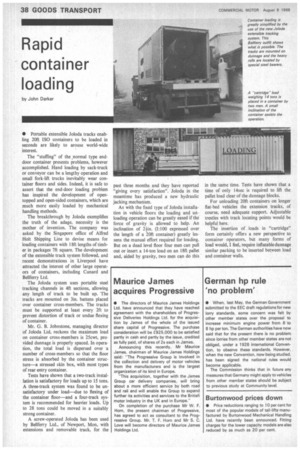Rapid container loading
Page 40

If you've noticed an error in this article please click here to report it so we can fix it.
by John Darker • POrtable extensible Joloda tracks enabling 20ft ISO containers to be loaded in seconds are likely to arouse world-wide interest.
The "stuffing" of the ,normal type enddoor container presents problems, however accomplished. Hand loading by sack-truck or conveyor can be a lengthy operation and small fork-lift trucks inevitably wear container floors and sides. Indeed, it is safe to assert that the end-door loading problem has inspired the development of opentopped and open-sided containers, which are much more easily loaded by mechanical handling methods.
The breakthrough by Joloda exemplifies the truth of the adage, necessity is the mother of invention. The company was asked by the Singapore office of Alfred Holt Shipping Line to devise means for loading containers with I 81t lengths of timber in packages 7ft square. The development of the extensible track system followed, and recent demonstrations in Liverpool have attracted the interest of other large operators of containers, including Cunard and Bellferry Ltd.
The Joloda system uses portable steel tracking channels in 4ft sections, allowing any length of track to be built up. The tracks are mounted on 3in. battens placed over container cross-members. The tracks must be supported at least every 2ft to prevent distortion of track or undue flexing of container.
Mr_ G. B. Johnstone, managing director of Joloda Ltd, reckons the maximum load on container cross-members is 25cwt, provided dunnage is properly spaced. In operation, the total load is dispersed over 'a number of cross-members so that the floor stress is absorbed by the container structure—a stressed skin box, with most types of rear entry container.
Tests have shown that a two-track installation is satisfactory for loads up to 15 tons. A three-track system was found to be unsatisfactory under load—due to flexing of the container floor—and a four-track system is recommended for heavier loads. Up to 28 tons could be moved in a suitably strong container.
A screw-operated Joloda has been used by Bellferry Ltd., of Newport. Mon, with extensions and removable track, for the past three months and they have reported "giving every satisfaction". Joloda in the meantime has produced a new hydraulic jacking mechanism.
As with the fixed type of Joloda installation in vehicle floors the loading and unloading operation can be greatly eased if the force of gravity is allowed to help. An inclination of (1:100 expressed over the length of a 20ft container) greatly lessens the manual effort required for loading. But on a dead level floor four men can pull out or insert a 14-ton load on an 18ft pallet and, aided by gravity, two men can do this in the same time. Tests have shown that ,a time of only 14sec is required to lift the pallet load clear of the dunnage blocks.
For unloading 20ft containers on longer flat-bed vehicles the extension tracks, of course, need adequate support. Adjustable trestles with track locating points would be helpful here.
The insertion of loads in "cartridge" form certainly offers a new perspective to container operators, but many forms of load would, I feel, require inflatable dunnage similar packing to be inserted between load and container walls.
















































































































































